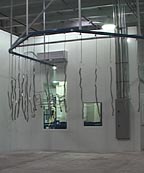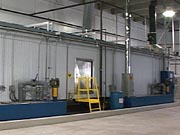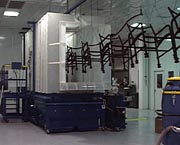Pavilion Furniture Becomes a Powder Coater
Pavilion Furniture Inc., a leading manufacturer of outdoor furniture used by hotels, resorts, country clubs and cruise lines, applies a high-quality coating to its product to withstand the harsh environment of a seacoast setting. The Miami-based company had been outsourcing its product to three different powder coaters, but it was not getting the quality it needed. In addition to quality issues, Pavillion was growing and it needed additional line time. With the pressure on to control quality and delivery, Pavillion decided to start a powder coating business to coat its own products and offer its services to other aluminum manufacturers.
The company built a 34,000-square-foot facility to house the new powder coating system, setting up shop as Aluminum Powder Coating LC (APC). The new line was designed and installed in February 2003, and the company began to powder coat parts two months later. Every feature of the system is focused on the quality standards that Pavilion demands.
APC was founded on the principal of custom finishing and exceptional service. As a result, the company not only handles all of the product for Pavilion Furniture, it also is the exclusive finisher for several other manufacturers. APC now coats railing, shutters, mail boxes, air conditioning components, electrical components, boating and lighting equipment, and many other products made of extruded aluminum.
Midwest Finishing Systems (Mishawaka, IN) worked with Pavilion Furniture to design, engineer and install the most efficient powder coating system available. They worked as a team with Joe Buzzella of Pavilion Furniture, José Benitez of Chemetall Oakite (Berkeley Heights, NJ) and Mario Hernandez of Famis, a local representative for Nordson Corp. (Amherst, OH).
The new powder coating system can handle parts up to 30 inches wide, 72 inches high and 20 feet long. The product opening is 42 inches wide and 84 inches high. The system is designed to operate at 6 to 8 fpm. The furniture is fabricated of aluminum to make it lightweight and corrosion resistant.

Pretreatment process
The critical factor for successful performance of powder applied to an aluminum substrate is the preparation of the surface. Aluminum has an oxide layer that must be removed and passivated to ensure adhesion of the powder. Chemetall Oakite recommended an acidic product developed for treatment of the aluminum that can properly treat the aluminum surface and handle the harsh environment where the product is used. The washer has three stages:Cleaner-The first stage chemical solution uses Oakite CrysCoat 747 LTS, an acidic aluminum cleaner/conditioner. It effectively removes soils and oxides typically associated with aluminum alloys. Unlike some alkaline cleaning/etching solutions, CrysCoat 747 LTS does not develop a smut during the cleaning/conditioning process. In addition, it does not contain silicates, so silicate dry-down is not a problem.
The tank capacity is 2,500 gallons. All of the tanks are fabricated of stainless steel for long life and corrosion resistance. The solution contact time is 90 seconds, and the nozzle pressure is 7 to 10 psig. The chemical concentration in the solution is automatically controlled to 3% and the pH 4.5. One of the nice features of this product is that it operates at temperatures between 100 and 110°F. With the recent increases in the cost of natural gas, this is a good, low-energy product.
Rinse-The second stage is an ambient water rinse with a tank capacity of 1,500 gallons. The contact time is 60 seconds, and the nozzle pressure is 5 to 8 psig. The volume of overflow from the rinse tank is automatically controlled to maintain the water quality below 600 ppm of hardness. Approximately 300 to 400 gallons per month of water is overflowed.
Nonchrome conversion coating-The third stage uses Okemcoat 4500, a liquid, acidic conversion coating for aluminum. This product is specifically designed for treatment of aluminum before coating. It does not contain chrome and does not require rinsing. The Oakite OkemCoat 4500 produces colorless to light-blue coatings, depending on treatment time, drying method and alloy. It provides excellent performance properties and physical test results when applied properly.
Using a single-package, nonchrome product that operates at ambient temperature and provides excellent salt spray results, as well as other physical performance characteristics, provides Pavilion the quality it needs at an affordable price.
The tank capacity in stage three is 1,500 gallons, and the contact time is 60 seconds. The solution's operating life is nine to 12 months. Overflowed water from the second stage is used as make-up for the first stage. Fresh water is added to the second and third stages as needed.
The solutions are controlled by an Oakite SnapShot 2001 system that monitors and records all of the operating parameters of the washer. It collects data from various points in the process, manipulates it through math functions, and exports it for immediate action if necessary. The processed data can be sent to controllers or to another computer for data collection. SnapShot 2001 can send a fax or page when the process is not working within proper parameters.
The drain decks of the washer are 21 feet long to allow room for the longest part to drain before entering the next stage. Misting nozzles are installed in the drain decks to keep the surface slightly wetted and prevent development of oxidation on the aluminum surface.
The modular design of the washer allowed Midwest to ship it to the job site already prefabricated, preplumbed, prewired and ready to set on the plant floor, thus eliminating a long installation time. It is built with stainless-steel parts for long life and insulated upper housing to enhance energy efficiency.
Dry-off
A manual drying station is positioned at the entrance to the dry-off oven. An operator can stand on a platform and use a compressed-air wand to blow excess moisture out of the tubing before the part enters the dry-off oven. This also serves as a standard QC station so that there's an inspection of the cleaned part before application of the coating. The dry-off oven is designed for six minutes of exposure at temperatures between 250 and 400°F.
Powder application
Following the dry-off oven, parts travel for approximately eight minutes before entering the powder room. The Pavilion team agreed that housing of the powder coating booths was a critical factor to the system. Harold Crane, sales engineer for Midwest Finishing Systems notes, "The environmental room is necessary because it allows the humidity, air quality and air flow to be controlled. When there are major color runs and reclaims, the powder has to be taken care of. Moisture and powder don't go together, and it's very humid here in Florida."The room, designed and installed by National Partitions, (Hialeah, FL), is 78 feet long, 33 feet wide and 14 feet high. Using prefabricated panels, the company was able to install the system quickly and keep the job site clean. The premanufactured panels are stood up on end, and the installation takes a lot less time than standard building construction. The precoated, steel-panel walls provide a high-quality surface that is easy to keep clean.
The installation saved time and got Pavilion into production much sooner. George Wirtz, environmental rooms manager for National Partitions, explains, "Conventional construction would have taken two or three months, and the building process is not as clean as a pre-engineered wall system. National Installer's crew was able to install the complete room, including the walls, roof, drop ceiling and electrical wiring, in about three weeks." The ease of installation, the durable and easy-to-clean finishes, the insulated wall and roof panels, and the accelerated depreciation made this type of building system an easy decision.
Nordson Corp. was selected to provide the powder booths and application equipment. Mario Hernandez of Famis worked with Midwest and Pavilion to determine what kind of reclaim capability was needed and to select the right application equipment and spray booths. Pavilion has many stock colors, but they also offer custom design, and so they work with a virtually unlimited number of colors.
Two cartridge module booths were selected to provide flexibility for color changes while recovering black, the highest volume color. Black is used on a high percentage of the company's furniture as a final coat or as a basecoat prior to applying special effects. The recovery booth is a Horizon 400 with a polypropylene canopy and two Surecoat handguns.
The second booth, which has a stainless steel canopy, is used for all the other colors. The oversprayed material is not reused. The collector modules have fluidized sections at the bottom, and the oversprayed powder is automatically transferred to scrap barrels.
Cure oven
The cure oven is designed with two zones that operate with independent heat supply systems and controls. The total available time in the oven is 22 minutes. With the two zones, Pavilion has the flexibility to control the cure cycle for different part masses and cure requirements.
The ovens from Midwest were built in modular sections that are ready to bolt together, enabling quick installation. There is no metal-to-metal contact throughout the oven, eliminating unnecessary heat loss through the oven walls.

Controls
One reason Pavilion worked with Midwest Finishing Systems was Midwest's control package. The company uses an Allen Bradley SLC 500 with a panel view 1000 screen to operate the system. The user-friendly graphics and menus designed by Midwest enable the system operators to adjust the system quickly and accurately. The control system provides a simple method of accurately adjusting the system and maintaining precise operating parameters.Going into the powder business was not a priority for Pavilion, but it needed to create a quality powder coater to match its approach to the furniture business. "It was not my intention to get into the powder coating business," says Michael Buzzella, Pavilion's president. "If more companies ran their businesses by showing a little caring attitude, by giving a fair turnaround time, keeping a somewhat reasonable schedule, having a person trained in customer service that was supported by management, and by following the specs for cleaning, treating and curing a product, their companies would enjoy a smoother running operation, be more productive and increase sales and profits simply by not losing customers."
Looking for a reprint of this article?
From high-res PDFs to custom plaques, order your copy today!





